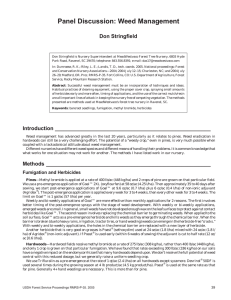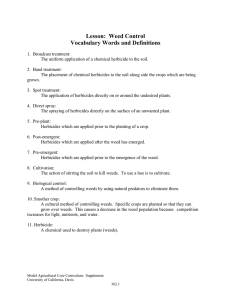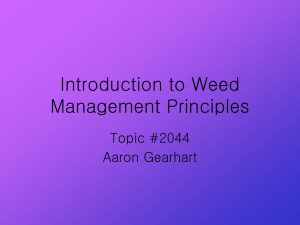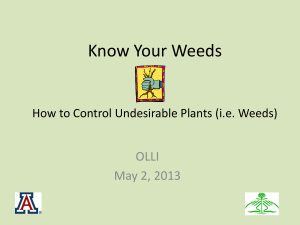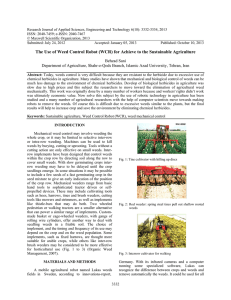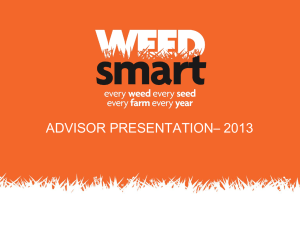11 * Management options for weeds
advertisement
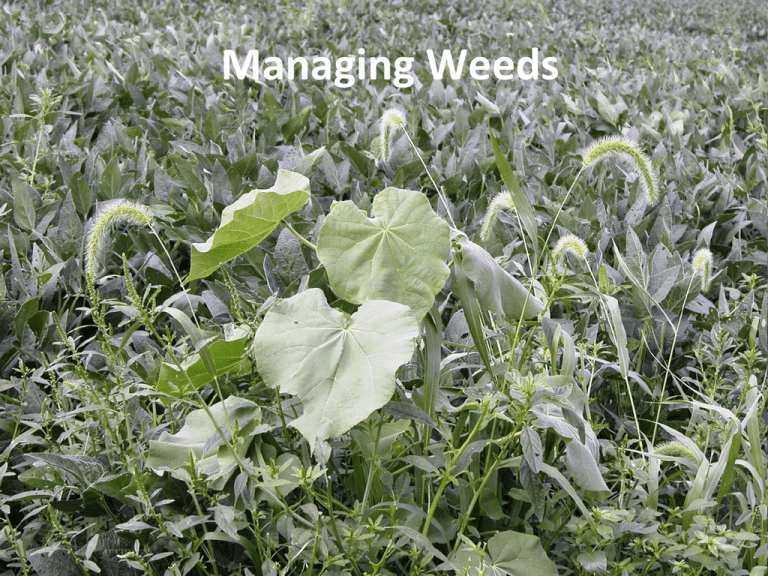
Managing Weeds Timeliness of weed control • Weeds are best controlled within the first several weeks after a crop is planted • Herbicides are more effective against smaller weeds • Smaller weeds are less competitive than larger weeds Maximize profit • Weed management programs should maximize profit, not just weed control • Some weeds may need 100% control if they are particularly competitive, persistent, or difficult to control Proper identification Identifying weeds is important for developing effective management plans Weed Control Preventative Cultural Mechanical Chemical Weed Control – Prevention Not allowing weeds to become established • Control in non-cropland areas • Plant weed-free crop seed • Not spreading manure, hay, or crop residue on fields that is contaminated with weed seeds • Clean machinery between fields • Eliminate “new” weeds that appear Weed Control – Cultural Altering the environment • Crop rotation • Cover crops and canopies Photos courtesy Laura Greiner Weed Control – Cultural Giving crops competitive edge • Narrow row spacing (soybeans) • Proper planting date and seeding rate • Using resistant varieties • Insect control • Adequate soil fertility • Adequate drainage • Seed treatments (soybeans) Weed Control – Mechanical Physical disruption of the environment • Tillage (both vegetative and seed) • Cultivation and rotary hoeing • Mowing • Mulching Weed Control - Chemical Herbicide use • Selective • Nonselective – Burn-down treatment • Rate and timing are critical Herbicide Decisions Soil-applied herbicides (preemergence) • • • • • Control weeds as seeds germinate Reduce early-season weed competition Protect yield potential Provide residual activity Provide greater flexibility in timing of postemergence herbicides Herbicide Decisions Postemergence herbicides • Target weed species not controlled by soil applications • Some control weeds emerged at the time of application • Others control emerged weeds and provide residual activity against later emerging weeds Selecting Herbicides Considerations from the previous year • Weed escapes the previous year • Environmental conditions that may be favorable for carryover • Herbicide-tolerant crops used Selecting Herbicides Considerations for the current year • Weeds present • Herbicide-tolerant crop plans • Tillage plans • Herbicide resistance development • Timing • Crop rotations for future years (carryover) • Label restrictions Herbicide Classes • Different classes of herbicides • Mode of action - mechanism by which a herbicide kills a plant • Site of action - Specific protein to which a herbicide binds, disrupting a physiological process in plants • Herbicides with the same mode of action may or may not have the same site of action Summary • Weed management is vital for maximizing crop production. • Because weed species vary in their response to different management strategies, proper identification is essential to develop effective management plans. • Weed management plans include preventative, cultural, mechanical, or chemical control methods that are specific to the particular cropping system and weeds present. • Control methods must be employed at the appropriate time for optimum results.


